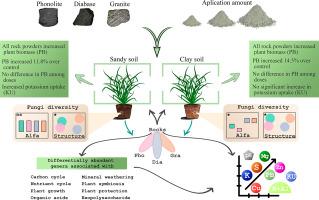高风化热带土壤中岩石粉末类型和土壤质地影响微生物群落变化和植物生物量响应
IF 5
2区 农林科学
Q1 SOIL SCIENCE
引用次数: 0
摘要
硅酸盐岩石粉可以提高土壤肥力,促进固碳,但其有效性取决于岩石类型、土壤特征和微生物反应。虽然在亚热带系统中报道了岩石粉应用后微生物的变化,但在高度风化的热带土壤中,人们对这些动态知之甚少。为了解决这一问题,我们将三种岩石粉末(phonolite,辉绿岩和花岗岩)以三种剂量(1.50,3.00和5.00 Mg ha - 1)施用于砂质和粘土热带土壤,并评估了它们对毛斑尾藻生物量,土壤肥力和微生物群落组成的影响。无论施用量如何,所有岩石粉均增加了植物生物量,其中5.00 Mg ha−1显著提高了沙质土壤的钾吸收。细菌多样性在很大程度上不受影响,而真菌群落对处理反应强烈,表明真菌是岩石粉施用的敏感指标。LEfSe分析显示,不同土壤类型和不同矿物改型的土壤微生物富集程度不同。在沙质土壤中,辉绿酶的施用促进了特定细菌属如Subgroup_7、放线菌属(Actinospica)、反刍菌属(Ruminiclostridium)和Rhodomicrobium的生长。相比之下,花岗岩修正选择性地丰富了两种土壤类型的真菌分类群,包括毛毛菌、曲霉、假假菌和Conoideocrella。这些富集类群与植物生物量、钾吸收和土壤化学性质相关,提示其在矿物风化和养分动员中具有功能作用。值得注意的是,植物生物量响应与土壤肥力参数的变化没有直接联系,这突出了微生物介导机制的重要性。这些发现强调了将矿物质-微生物相互作用纳入热带土壤肥力和管理框架的必要性。本文章由计算机程序翻译,如有差异,请以英文原文为准。

Rock powder type and soil texture shape microbial community shifts and plant biomass responses in highly weathered tropical soils
Silicate rock powders can enhance soil fertility and contribute to carbon sequestration, but their effectiveness depends on the rock type, soil characteristics, and microbial responses. While microbial shifts following rock powder application are reported in subtropical systems, little is known about these dynamics in highly weathered tropical soils with contrasting textures. To address this, we applied three rock powders (phonolite, diabase, and granite) at three doses (1.50, 3.00, and 5.00 Mg ha−1) to sandy and clay tropical soils and evaluated their effects on Urochloa brizantha biomass, soil fertility, and microbial community composition. All rock powders increased plant biomass regardless of application rate, with 5.00 Mg ha−1 significantly enhancing potassium uptake in sandy soil. Bacterial diversity was largely unaffected, whereas fungal communities responded strongly to treatments, indicating that fungi are sensitive indicators of rock powder application. LEfSe analysis revealed distinct microbial enrichments depending on both soil type and mineral amendment. In sandy soils, the application of diabase promoted specific bacterial genera such as Subgroup_7, Actinospica, Ruminiclostridium, and Rhodomicrobium. In contrast, granite amendment selectively enriched fungal taxa in both soil types, including Chaetomium, Aspergillus, Pseudallescheria, and Conoideocrella. These enriched taxa were correlated with plant biomass, potassium uptake, and soil chemical properties, suggesting functional roles in mineral weathering and nutrient mobilization. Notably, plant biomass responses were not directly linked to changes in soil fertility parameters, highlighting the importance of microbially mediated mechanisms. These findings emphasize the need to incorporate mineral-microbe interactions into tropical soil fertility and management frameworks.
求助全文
通过发布文献求助,成功后即可免费获取论文全文。
去求助
来源期刊

Applied Soil Ecology
农林科学-土壤科学
CiteScore
9.70
自引率
4.20%
发文量
363
审稿时长
5.3 months
期刊介绍:
Applied Soil Ecology addresses the role of soil organisms and their interactions in relation to: sustainability and productivity, nutrient cycling and other soil processes, the maintenance of soil functions, the impact of human activities on soil ecosystems and bio(techno)logical control of soil-inhabiting pests, diseases and weeds.
 求助内容:
求助内容: 应助结果提醒方式:
应助结果提醒方式:


